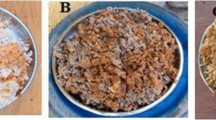Abstract
Zinc incorporation and the growth of Saccharomyces cerevisiae were investigated in a culture supplemented with three inorganic zinc salts, i.e. zinc sulphate, zinc chloride and zinc nitrate. The cultivation was performed on a yeast extract peptone dextrose (YEPD) broth medium. The growth of yeast was carried out at different concentrations of zinc, i.e. 0, 30, 60, 90 and 120 mg 100 ml−1. It was found that the addition of different zinc sources at 30 mg 100 ml−1 concentration produced higher biomass yield ranging 1.00–1.03 g from 100 ml−1 of cultivation medium, while higher zinc concentration in the medium caused significantly lower yields of yeast biomass. The amount of zinc in yeast cells was determined by an atomic absorption spectrometer (AAS). The highest amount of zinc in yeast cells was achieved when added in the form of zinc sulphate at a concentration of 120 mg 100 ml−1. The increment of intracellular zinc was up to 9889.67 mg kg−1 of biomass.
Similar content being viewed by others
Data Availability
The datasets generated during and/or analyzed during the current study are available from the corresponding author on reasonable request.
References
Berg JM, Tymoczko JL, Stryer L (2002) Biochemistry. 5th Edition. W. H. Freeman Publishing, New York, 270, 465, 687
Blackwell KJ, Singleton I, Tobin JM (1995) Metal cation uptake by yeast: a review. Appl Microbiol Biotechnol 43:579–584
Templeton DM, Ariese F, Cornelis R, Danielsson LG, Muntau H, Van Leeuwen HP, Łobiński R (2000) Guidelines for terms related to chemical speciation and fractionation oftrace elements: definitions, structural aspects, and methodological approaches. Pure Appl Chem 72(8):1453–1470
Cornelis R, Crews H, Donard O, Ebdon L, Pitts L, Quevauville J (2001) Summary paper of the EC Network on trace element speciation for analysts, industry and regulators-what wehave and what we need. J Environ Monit 3:97–101
Nelson N (1999) Metal ion transporters and homeostasis. EMBO J 18(16):4361–4371
Cohen A, Nelson H, Nelson N (2000) The family of SMF metal ion transporters in yeast cells.J. Biol Chem 275:33388–33394
Dobrzanski Z, Jamroz D (2003) Bioavailability of selenium and zinc supplied to the feed forlaying hens in organic and inorganic form. EJPAU 6:1–8
Rebar EJ, Miller JC (2004) Design and applications of engineered zinc finger proteins. Bio Tech Int 16(2):20–24
Bhagavan NV (2002) Medical biochemistry. Canada: Harcourt Academic Press, 2002. 897 p. ISBN 0–12–095440–0
Sekler I, Sensi SL, Hershfinkel M, Silverman WF (2007) Mecha-nism and regulation of cellular zinc transport. Mol Med 13(7–8):337–343. https://doi.org/10.2119/2007-00037. Sekle r
De Nicola R, Hall N, Bollag T, Thermogiannis G, Walker GM (2009) Zinc accumulation and utilization by wine yeasts. Int J Wine Res 1(2009):85–94
De Nicola D, Hall N, Melville SG, Walker GM (2009) Influence of zinc on distiller’s yeast:cellular accumulation of zinc and impact on spirit congeners. J Inst Brew 15(3):265–271
De Nicola R, Walker GM (2009) Accumulation and cellular distribution of zinc bybrewing yeast. Enzyme Microb Technol 44(4):210–216
Godlewska-Zlkiewicz B (2006) Microorganisms in inorganic chemical analysis. Anal Bioanal Chem 38(4):114–123
Liu FX, Supek F, Nelson N, Culotta VC (1997) Negative control of heavy metal uptake by theSaccharomyces cerevisiae BSD2 gene. J Biol Chem 272(18):11763–11769
Jones RP, Gadd GM (1990) Ionic nutrition of yeast: physiological mechanisms involved and implications for biotechnology. Enzyme Microb Technol 12:1–17
Bromberg SK, Bower PA, Duncombe GR, Fehring J, Gerber I, Lau VK, Tata M (1997) Requirements for zinc, manganese, calcium and magnesium in wort. J Am Soc Brew Chem 55:123–128
Konopka A, Zakharova T, Bischoff M, Oliver L, Nakatsu C, Turco RF (1999) Microbial biomassand activity in lead contaminated soil. Appl Environ Microbiol 65:2256–2259
Šillerová S, Lavová B, Urminská D, Poláková A, Vollmannová A, Harangozo Ľ (2012) Preparationof zinc enriched yeast (saccharomyces cerevisiae) by cultivation with different zinc salts. JMBFS 1:689–695
Roepcke CBS, Vandenberghe LPS, Soccol CR (2011) Optimized production of Pichia guilliermondiibiomass with zinc accumulation by fermentation. Anim Feed Sci Technol 163:33–42
Daniel JK, Paul KH, Scott DE (1990) The fungal vacuoles composition, function and biogenesis. Microbiol Rev 54:266–292
Funding
This study was funded by SERB (SB/EMEQ-476/2014); Department of Poultry Science, College of Veterinary Science, Rajendranagar, Hyderabad, India – 500 030; and Directorate of Poultry Research Hyderabad, India.
Author information
Authors and Affiliations
Corresponding author
Ethics declarations
Ethics Approval
Approval was obtained from the ethics committee of P V Narsimha Rao Telangana Veterinary University, Rajendranagar (IAEC No/IV/2019–10/CVSc, Hyderabad Date: 10–10-2019).
Consent to Participate
Informed consent was obtained from all individual participants included in the study.
Competing Interests
The authors declare no competing interests.
Additional information
Publisher's Note
Springer Nature remains neutral with regard to jurisdictional claims in published maps and institutional affiliations.
Rights and permissions
About this article
Cite this article
Naik, R.P., Preetam, V.C., Kumari, N.N. et al. Effect of Different Zinc Sources and Concentrations on the Biomass Yield of Saccharomyces cerevisiae Yeast. Biol Trace Elem Res 200, 4171–4174 (2022). https://doi.org/10.1007/s12011-021-02998-3
Received:
Accepted:
Published:
Issue Date:
DOI: https://doi.org/10.1007/s12011-021-02998-3




